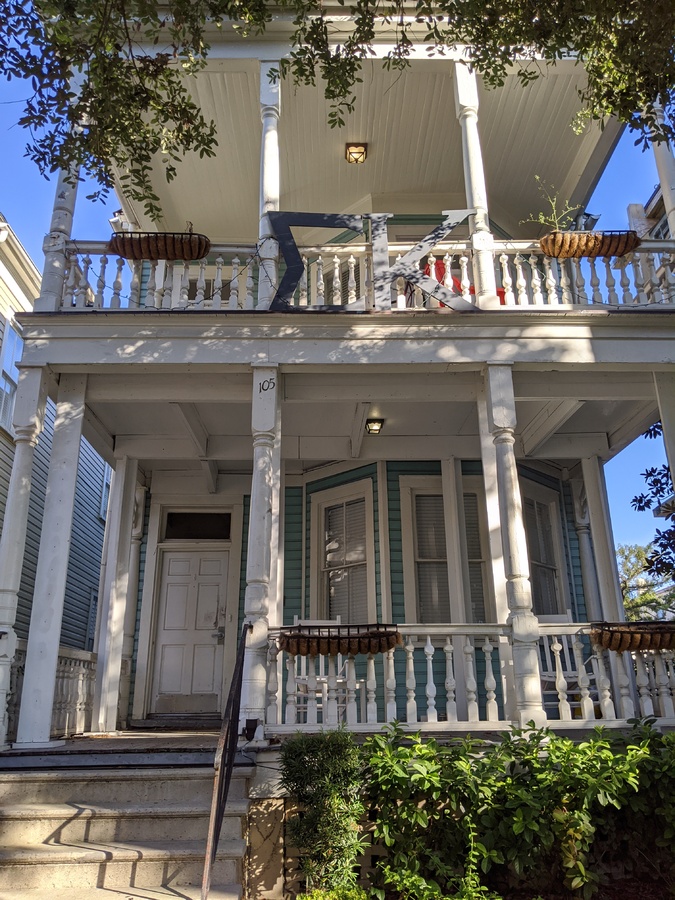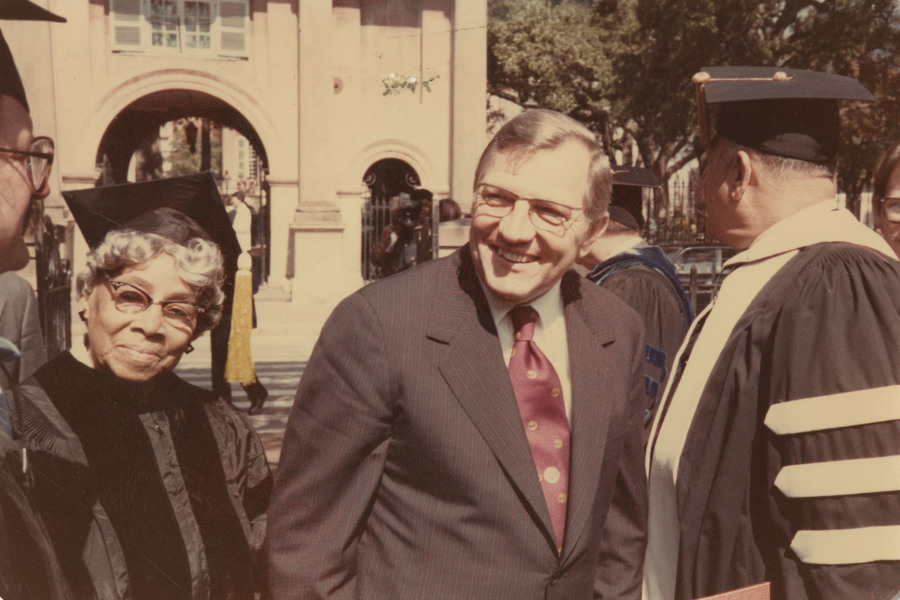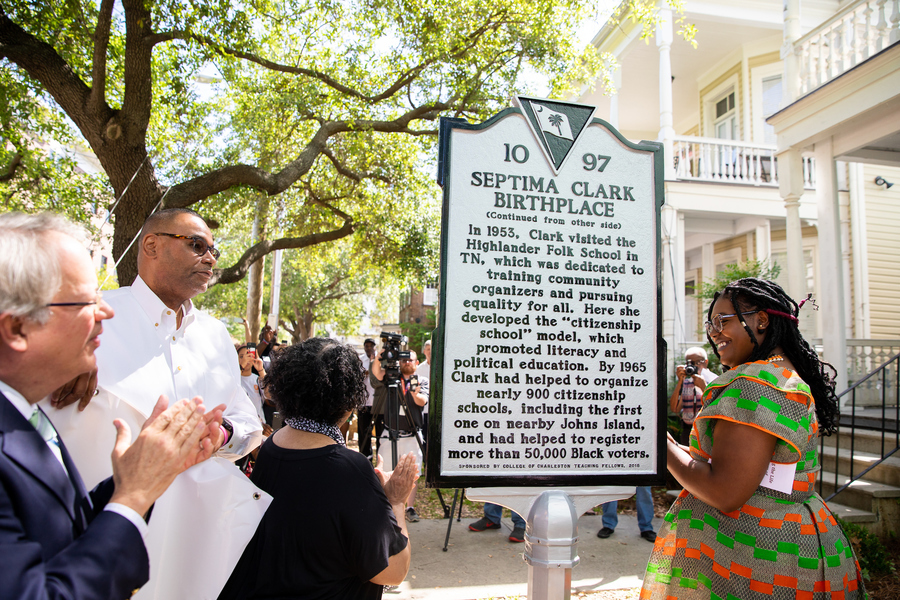Septima P. Clark Birthplace, 105 Wentworth

At 105 Wentworth Street stands College of Charleston’s Kappa Sigma Fraternity house. Beyond the surface of a residential home for the College’s frat life, this property holds a special part of Charleston’s Black history. On May 3rd, 1898, Septima Poinsette (she later became Clark when she married Nerie Clark in 1920) was born on this site.
At 105 Wentworth Street stands College of Charleston’s Kappa Sigma Fraternity house. Beyond the surface of a residential home for the College’s frat life, this property holds a special part of Charleston’s Black history. On May 3rd, 1898, Septima Poinsette (she later became Clark when she married Nerie Clark in 1920) was born on this site. Clark was a civil rights activist who helped establish citizenship schools on Johns Island in 1957 that later spread throughout the South. Over the years, she served as a mentor to young Black women through organizations such as the YWCA. She emphasized the importance for Black people and communities of color to be politically involved and her activism led to noteworthy awards and accomplishments. In 1972, she was the first African American member elected to the Charleston County School Board. In 1979, President Jimmy Carter awarded her with the Living Legacy Award and in 1982, the state of South Carolina awarded her with the Order of the Palmetto, the most esteemed honor for civilians. She passed away in 1987 at the Sea Island Health Center, a facility established by alumni of the Johns Island Citizenship School. 105 Wentworth’s significance to Charleston history is clearly remarkable.
The property at 105 Wentworth Street was the home of her parents, Peter Porcher Poinsette (b. 1850) and Victoria Warren Anderson Poinsette (b. 1870). Peter, an enslaved man, was born on Joel Poinsett Plantation near Georgetown. Victoria’s family was free before the civil war and Victoria herself was born in Charleston and reared in Haiti. Victoria and Peter married in the early 1890s. After giving birth to Septima and Peter Poinsette Jr., the family moved from Wentworth in 1904 to 17 Henrietta Street. Currently, all that marks 17 Henrietta Street is a plaque that is behind the historic Mother Emanuel AME Church.
During the early twentieth century, Wraggborough was home to many diverse types of people; it was home to African Americans, Germans, Irish, and Italians. In 1948, Septima P. Clark purchased 17 Henrietta. This was a noteworthy accomplishment since homeownership constituted some form of citizenship. The segregation period hindered the ability for African Americans to purchase property at this time. Clark’s impact on Charleston’s history was not limited to just being a property owner. She focused her attention on racial justice for all children and adults in the country, but specifically in South Carolina. Her life was dedicated to preserving a quality and just education system during the Jim Crow era and beyond.
As a teenager, Septima went to the Avery Normal Institute to become a teacher during a time when Charleston County did not allow Black educators to instruct white children or in city schools. Due to this ordinance, she started teaching on Johns Island in 1916 with the help of Reverend E.B. Burroughs. In 1919, she went back to Avery to further her teaching career. While at Avery, the young educator began participating in door-to-door campaigns to obtain enough signatures that would permit Black educators to teach at Black schools, thereby replacing white educators in Black schools, which was the norm. The campaign was successful, as Charleston passed a law that opened the door to Black educators. Clark saw the importance for Black students to have teachers who understood their lives and situations from first-hand experience. People of color needed to have teachers and role models to show them what their futures could look like. This position of authority for African Americans had been denied to them until this point. Despite this victory for African Americans in Charleston, segregation left them to face inequality within the school system. Prior to 1954, there was “little attempt to provide adequate education for Negro citizens. The school year was broken up by the cotton crop, the tobacco crop and any other crop which needed harvest or care.” A school year divided by crop seasons can be explained as an underlying legacy of slavery in the South under the Jim Crow era.
Clark explained how inequitable the school system was for Black youth prior to 1954:
But what of those who received their training prior to 1954? Those were the bleak years of so called separate but equal facilities which always managed to be separate, but which left the Negro child in a one-room school with a small blackboard, a bucket, a dipper[,] and the battered textbooks that were passed down from the white school children after they were too ragged for their use. In spite of the inequity, this system has proven detrimental to the masses of both races.
Her words expressed the difficulty that children endured in their education because of the color of their skin.
Clark spoke about inequality in the education system at a time when civil rights movements were becoming stronger than ever. Her activism was inspired by Reverend Dr. Martin Luther King, Jr. She witnessed firsthand how difficult it was for Black men and women to participate in the electoral system due to citizenship tests at the polls. As a method to combat the disenfranchisement of the Black electorate, she helped develop citizenship schools in the South as an extension of the Southern Christian Leadership Conference’s Citizenship Education Program. The goals of the program were as follows: 1.) To provide basic literacy skills, 2.) To feed, educate, or heal an individual regardless of the community they came from, or system of government they identified with “which has contributed to the deprived state of the individual,” and 3.) To train one or two people to help them teach their neighbors about the way in which the ballot is used to create and continue the rule of Liberty and Justice for all.
In 1956, Clark was fired from the Charleston County school system because she was a member of the National Association for the Advancement of Colored People (NAACP). Unfortunately, it was common for African Americans to face discrimination for membership in this civil rights organization. The life and career of Clark is a profound example of the pursuit for justice and equity in Charleston, South Carolina. The struggles that people of color endure in the Charleston County School District have roots from slavery, through Jim Crow, and now in modern times. Clark’s words can be used to describe the struggles that African Americans and people of color endured, and which persist today as an example of the modern legacy of institutionalized slavery:
In one hundred years since slavery the Negro has struggled to overcome the attempts to transform that once legal slavery into more subtle forms of educational, economic, and political slavery.
Septima P. Clark recognized that the continuous cycle of inequity, discrimination, and racism within the school system in the modern United States was, and still is, prevalent.
Images



